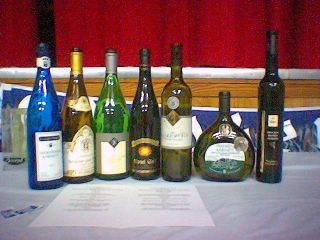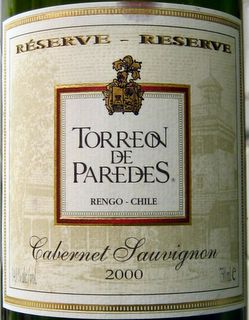Wednesday, December 28, 2005
Scientists working to improve wine
"Lorenz 'Larry' Biegler, who teaches chemical engineering at the university, is working on mathematical formulas to automate the fermentation process, adjusting ingredients and conditions to ensure robust flavors and higher yields from grape harvests."
We'll drink to that.
Monday, December 19, 2005
More on screw caps
Oddly enough, for what it's worth, the last New Zealand wine we had was corked.
On the other hand, it was a chardonnay, which we bought without reading the label closely enough--we thought it was a sauvignon blanc. (Cloudy Bay makes chardonnay, too, apparently. Who knew?)
Friday, December 16, 2005
Do you dab it on your wrist, or drink it?
We've got many, many wines to blog about when we get an hour or two...over Christmas, perhaps?
Except, of course, then we'll have even more wines to blog about...
Tuesday, November 29, 2005
More good health news about red wine
Research presented at a recent American College of Rheumatology meeting in San Diego shows that:
"...resveratrol, a powerful antioxidant found in certain types of grape, appears to halt the damage done to cartilage - the gristle-like substance that covers the ends of bones in a joint - and speed up recovery."
Waiter! Another glass of Shiraz!
Tuesday, November 08, 2005
Wine tasting on the brain
The weekend before last we attended the International Wine and Food Festival at the Banff Springs Hotel. (A dirty job, but someone’s got to do it.) At the event, top wine makers from around the world led 250 attendees through tastings of some of their offerings.
Among the guests on hand was Neil Beckett, editor of Fine Wine magazine. Copies of the latest issue were provided, and in it I discovered a fascinating article by Dr. Jamie Goode, a plant biologist and wine writer (and author of the new book Wine Science.)
Provocatively titled “Brainwashed by Winetasters?”, the article provides an overview of recent research into what goes on in our heads when we taste wine—and what that means for those much-loved numerical ratings of wine by famous wine tasters.
Dr. Goode points out that we would be completely overwhelmed by the information provided by our senses if our brain did not edit the incoming data. What we perceive as a complete picture of reality is really just a sketchy representation based on what the brain thinks is important.
Through functional magnetic resonance imaging (fMRI) studies, which reveal details of brain activity, we know that “flavour” is really synthesized in the brain’s orbitofrontal cortex from, not just taste, but also smell, touch and vision.
Eating a lot of something dulls this response, which is why the turkey that seemed so tantalizing when you started Christmas dinner loses its appeal over the course of the meal, but pumpkin pie for dessert can still tempt you.
This has obvious implications for wine tasters. In a trade tasting, tasters might taste 100 wines in one session. Tasting too many wines with similar characteristics may influence their perception of the later wines.
To be fair, trade testers have more analytical tools at their command than amateurs. Dr. Goode reports that a study in Rome in 2002 found that in professional sommeliers, unlike in non-tasters, an area of the brain related to an expectation of reward or pleasure lit up before the wine was tasted, and after the tasting, an area of the brain involved in planning and using thinking strategies lit up, probably because the sommeliers were mentally searching for words to describe the experience.
But just because you’ve taught yourself to analyze and describe wine doesn’t mean your description will match anyone else’s. Frederic Brochet, a cognitive psychologist, has found that each professional taster develops his or her own distinctive vocabulary for describing wine—and that the brain response to a specific wine differs from taster to taster, and even in an individual from tasting to tasting.
He has also discovered that even professional wine tasters can be fooled by their brains’ unconscious assumptions. He asked 54 subjects to describe a red wine and a white wine. A few days later, he again had them taste a red wine and a white wine—but this time the “red” wine was really just the white wine tinted with a neutral-tasting food colorant. In both experiments, the tasters used the same terms for the “red” wine. Brochet concluded vision plays a bigger role in our perception of wine flavour than we realize: we expect the taste of a red wine to fall within certain parameters, so our brain obligingly makes any red wine we taste fall within those parameters.
In a related study, Brochet served the same average-quality wine to subjects twice, with a week’s gap between servings, first packaging it as a table wine, then as a grand cru wine. At the second tasting, the tasters, thinking they were tasting a grand cru wine, used terms like “complex” instead of “simple” and “balanced” instead of “unbalanced.” The wine hadn’t changed: their perception of it had. Their brains had made some helpful assumptions, and there was nothing they could do about it: they were fooled from the moment they saw the bottle.
Dr. Goode concludes that every wine-taster’s response to every wine is unique. That doesn’t mean that tasting notes from experienced tasters are useless. Through experience and learning (as at Banff), wine tasters build up a consensual representation of reality, so that another experienced taster’s notes can provide useful information. But, in the end, your response to a wine is yours and yours alone: your background has as much influence on whether or not you like a wine as does the winemaker, the vintage or the terroir.
In other words, a good wine is a wine you like.
European wine fighting for survival?
Thursday, November 03, 2005
Another reason red wine is good for you!
A study published in the November 11 issue of the Journal of Biological Chemistry shows that resveratrol, a compound found in grapes and red wine, lowers the levels of the amyloid-beta peptides which cause the telltale senile plaques of Alzheimer's disease.
Saturday, October 22, 2005
Innovation in German wines
We're particularly taken with the picture illustrating the use of a glass stopper instead of a cork. That's a new one on us!
The pertinent passage:
Embracing new trends doesn't mean having to forego tradition. Hans-Josef Becker uses many of the same techniques as his grandfather. At the same time, he's not afraid to tinker. He was the first German grower to use glass stoppers instead of corks.
"It's really easy to remove the glass stopper," Becker said. "And you can close it again so that you can put the bottle in the refrigerator."
Becker decided to switch to glass stoppers because of the declining quality of natural corks: the more delicate a wine is, like the dry Rieslings in his region, the more sensitive it is to unpleasant aftertastes or changes that can come about because of the cork. The glass stoppers have helped avoid spoiled bottles and won over customers.
Interesting. We wonder if we'll see any of these glass-stoppered wines over here?
Sunday, October 16, 2005
The German Wine Society at the German Club
Last night we attended the German Wine Society of Regina's dinner and tasting at, appropriately enough for October, the German Club. The traditional Oktoberfest beverage was not in evidence, but lots of good wine certainly was, and an absolutely delicious dinner that kept us surprised and delighted all evening long.
Here are our notes on the wine, pictured, alas, only in the accompanying low-res photograph from our Audiovox Harrier (from left to right, in the order we tasted them):
Reception
Gustav Adolf Schmitt Kabinett, Rheinhessen, 2001
Margaret Anne wasn't big on this, finding it a little thin for a Kabinett. Ed tasted lots of sweet apple to begin with, but for some reason the finish was rather sour and bitter. Alice (Margaret Anne's mom, not our four-year-old daughter, who, although present at the dinner, likes her grape juice unfermented) also found it nice and fruity, but also didn't like the aftertaste.
St. Ursula Niersteiner Gutes Domtal Kabinett, Rheinhessen, 2000
We all preferred this to the Schmitt; it just seemed to have more characters. Someone at the table said it was sweeter than the first one, although Ed didn't think so. His comment was that it definitely had that "gasoline" or "diesel" bouquet that is typical of some Reislings--but he meant that in a good way.
Martinshof Huxelrebe Kabinett, Pfalz, 2003
We last had this at the German Wine Society tasting at the Willow on Wascana. We adored it then, and ordered four one-litre bottles through the GWS when it put in its group order to Germany. We haven't opened one of those yet, but we will soon, because this was, without a doubt, or favorite wine of the evening (with the possible exception of the dessert choice). It had a rich, rich mouth feel and a wonderful caramel flavor. It was a perfect pairing with the appetizer. "Beautiful" was the most common comment around the table. Someone else at the event claimed the taste was rhubarb, but to us, it's unmistakeably caramel. (Ed really doesn't like rhubarb, so he would never insult a wine he enjoyed by referencing what he calls "mutated celery.")
Soup: German Mussel Chowder
Mosel Gold QBA, Mosel Saar Ruwer, 2002
The weakest wine we'd yet had. "A bit musty," said Margaret Anne. To be fair, it didn't go too badly with the soup, although it certainly wasn't as inspired a match as the Huxelrebe with the herring (and, in fact, according to Margaret Anne, who'd hung on to some of hers, the Huxelrebe went better with the soup than the Mosel Gold did).
Entrée: Pork Tenderloin in a Rye Crust with Honey German Mustard Sauce, Served on a Bed of Herbed Spaetzle with German Rosette Beets
Martinshof Cuvee Ruben Trocken, Pfalz, 2003 Frickenhauser Kapellenberg Kabinett Bacchus, Franken, 1999
Dessert: German Brandied Apple Pancakes with Caramel and Chocolate Sauce
Heinheimer Kafer Ortega Sybilstein Trockenbeerenauslese (TBA), Rheinhessen, 1998
As beautiful as one would expect. Deep gold colour. Rich, buttery mouth feel. Very sweet, of course, with strong flavours of honey and raisin, but still a touch of acidity to keep it from being cloying. Margaret Anne summed it up simply: "It's a great dessert wine." Ed, who strongly believes dessert wines should be enjoyed on their own rather than trying to match them to desserts, drank his before dessert even arrived. Margaret Anne still had some of hers, and pronounced the combination of the wine and the brandied apple pancakes one of the better dessert/wine pairings she's run across.
Thursday, October 13, 2005
Tuesday, October 11, 2005
Martinshof Gewürztraminer Spätlese 2003

Martinshof Gewürztraminer Spätlese 2003
A wine we ordered direct from Germany through the German Wine Society, this Martinshof Gewürztraminer was everything we like in German wine. Lichee, sweet apple, with a nice, non-acidic mouth feel. Full-flavoured, and a long, long finish. Yum! We give this a solid 8/10 and would definitely buy it again.

Au Bon Climat Pinot Noir 2003

Au Bon Climat Pinot Noir 2003
This Au Bon Climat Pinot Noir from California's Santa Maria Valley, purchased on the recommendation of the staff at a Calgary wine store while we were there this summer (it's not one we've seen locally), has a deep garnet colour, a lovely and big bouquet and a big but nicely balanced flavour to match. Cherries came to mind predominantly, but it was hard to pick out a lot of individual notes from the harmonious whole of the taste. Our rating: 7.5/10. We'd definitely buy it again, given the opportunity.

Vineland Estates Chardonnay 2004

Vineland Estates Chardonnay 2004
We've joined the Vineland Estates wine society, through which we receive two bottles of wine each month, and a complementary recipe, for $35. Vineland Estates is one of our favorite Niagara Peninsula wineries, and we're really enjoying what they've been sending us (especially since we can't get it in our local liquor stores).
Case in point: this Chardonnay. Unoaked, it immediately hit us with the smell and taste of melon and citrus, while lacking that strong vanilla flavor we sometimes associate with Chardonnay. In fact, it reminded us more of a Sauvignon Blanc than a Chardonnay--which is a good thing, since we both prefer Sauvignon Blancs to Chardonnays, as a rule. It went well with spaghetti, even matching the saltiness of the ham in the sauce and the parmesan on top. Very good. Our rating: 7.5/10.

Veuve Cliquot Ponsardin Champagne
Terra Nova Carménère 2003
Monday, October 10, 2005
Aging wine in seconds?
Now comes word of a device that may be able to quickly age entire barrels of wine before bottling, and that seems, at first glance, anyway, to have a more scientific rationale:
Squirrelled away in his chemical engineering laboratory in rural Shizuoka, Hiroshi Tanaka has spent 15 years developing an electrolysis device that simulates, he claims, the effect of ageing in wines. In 15 seconds it can transform the cheapest, youngest plonks into fine old draughts as fruit flavours are enhanced and rough edges are mellowed, he says.
Among those keeping tabs on the research: the Robert Mondavi winery.
Is the wine cellar about to become obsolete? Stay tuned...
Friday, October 07, 2005
If you really want Canadian wine...
Thursday, October 06, 2005
2005 a good vintage in Ontario
The bad news: there won't be as many of them.
Tuesday, October 04, 2005
Fetzer Valley Oaks Fumé Blanc 2004

Fetzer Valley Oaks Fumé Blanc 2004
We had this at the Creek in Cathedral Bistro, one of our favorite restaurants, where we celebrated our eighth wedding anniversary. (It was rather dim, which is why the label looks a little...odd.) This Fetzer Valley Oaks Fumé Blanc had a floral nose, but with a bit of grassiness. Very fruit-forward; a big flavor, with lots of alcohol. The label talks about lemon, green apple and mint and, to Ed at least, seemed an accurate description. We'd definitely buy again, but we didn't give it a rating because, well, it was our anniversary, and whatever we drank would have seemed like ambrosia.
No, really!
Gray Monk Pinot Auxerrois 2004

Gray Monk Pinot Auxerrois 2004
This Gray Monk Pinot Auxerrois from the Okanagan is "Delicious!", in our considered opinion. A bit of a gasoline (i.e., Riesling) scent, but thought it sounds odd to say so, that was OK. Very pale, almost grayish in colour. Tart peach flavours, a lingering finish. We would definitely buy this again, and we give it 8/10.
McWilliams Hanwood Estate Shiraz 2002
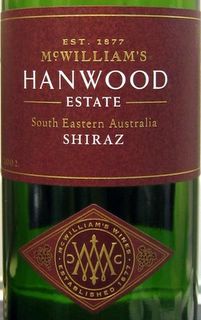
McWilliams Hanwood Estate Shiraz 2002
We don't have much to say about this McWilliams Hanwood Estate Shiraz: it's simply a good solid Shiraz, not as flavorful as the E&E Pepper Shiraz we really, really like, but flavorful enough, and with a very nice bouquet. Our rating out of 10: 6.5.
Sunday, September 18, 2005
McWilliam's Chardonnay Colombard 2004

McWilliam's Chardonnay Colombard 2004
This McWilliam's Chardonnay Colombard is nice and citrusy without too much oak, and with just the right amount of butteriness to the mouth feel--enough to let you know you're drinking a chardonnay without completely removing the crispness. Not particularly complex, but very pleasant to drink. Our rating out of 10: 6.5.
Deakin Estate Victoria Shiraz 2002

Deakin Estate Victoria Shiraz 2002
This Deakin Estate offering is a good, basic Shiraz, with lots of plum and black pepper flavour, and a pretty good match for spicy food. It's reasonably priced in Saskatchewan at about $12. Our rating: 6/10.
Cuvée Alice... Corbières 2003

Cuvée Alice... Corbières 2003
Well, we had to buy this one, didn't we, since both our four-year-old and Margaret Anne's mom are named Alice? We spotted it in Calgary and snapped up six bottles.
Ruby red in colour, well-balanced, fruity, but with a nice layer of tannin to keep it dry. A hint of strawberry in the flavour, perhaps. On the nose, wood, maybe cedar...certainly a more herby than floral bouquet. Margaret Anne really likes this one, rating it 9/10; Ed isn't quite as enthusiastic, but gives it a 7/10. Anyway, we'll definitely buy more of it (in fact, Ed will be in Calgary in the next few days and plans to pick up a couple more bottles), for the label, if nothing else!
Wednesday, August 24, 2005
Presto preservo!
Saturday, August 13, 2005
Torreon de Paredes Cabernet Sauvignon 2000
Hardy's Riesling Gewurztraminer 2004

Hardy's Riesling Gewurztraminer 2004
This Hardy's Riesling Gewurztraminer was more Riesling than Gewurztraminer to our taste, complete with a bit of that "diesel" smell that's the distinctive Riesling odor. (We know, we know, German winemakers hate it when you call that smell "diesel," but we don't mean it negatively.) Overall, pleasant, citrusy and crisp; not a particularly complex wine, but a good one for sipping and very food-friendly. Our rating: 7/10.
Davis Bynum Russian River Valley Pinot Noir 2000

Davis Bynum Russian River Valley Pinot Noir 2000
Beautiful nose, with a hint of strawberries. Fruity, but well-balanced. Margaret Anne thought it had a touch of effervescence. Ed liked this Davis Bynum Pinot Noir more than Margaret Anne, though; Margaret Anne said she wanted to like it more than she did. Both of us rated the bouquet 9/10; Ed's overall rating 8/10, Margaret Anne's 6/10.
This cost us $30 or $35 U.S.; we bought it in Sonoma during our trip there in 2002.
Friday, August 12, 2005
Lamberti Santepietre Bardolino Chiaretto Classico 2003
Water Wheel Bendigo Shiraz 2003
Gustav Dickenscheid Rheinhessen Ockenheimer Schönhölle Riesling Spätlese 1993

Gustav Dickenscheid Rheinhessen Ockenheimer Schönhölle Riesling Spätlese 1993
We confess we never know when to stop when it comes to transcribing the names of German wines off of the traditional German labels...
In any event, this was quite spectacular, after 12 years in the bottle. It had a gorgeous golden colour, and was a splending example of a high-quality Riesling, with apricot and what some people characterize as petroleum (but in a good way!) flavours. We rate it 9/10. And we may just have another bottle of it tucked away yet...
E&E Barossa Valley Sparkling Shiraz 1999
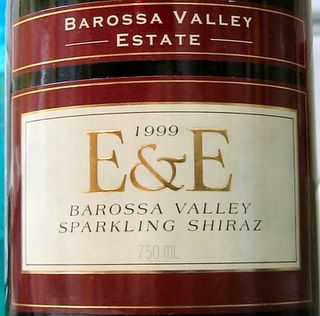
E&E Barossa Valley Sparkling Shiraz 1999
This is a $65 bottle of wine, when you can find it, which you can't, in Regina. Fortunately, Richmond Hill Wines in Calgary brings it in, and this summer we were in Calgary earlier than usual--which meant they hadn't yet sold out of the limited supply. We stocked up, so we now have a couple of bottles in waiting.
This 1999 bottle of the E&E Barossa Valley Sparkling Shiraz was one we already had on hand from a previous purchase, and we opened it for Ed's birthday. It had a deep, rich flavour. We find that some sparkling wines seem artificially sweet. Not this one: it's simply a full-bodied shiraz that happens to sparkle. Its fruity, but nobody could ever call it jammy. And it's very, very smooth.
It is, in fact, one of our absolute favorites, which is why our rating is 9/10.
Pelee Island Winery Eco Trail 2004

Pelee Island Winery Eco Trail 2004
Clean, crisp and citrusy on both nose and palate, with the first sip strongly reminding us of pineapple and orange juice. We'd never had this Pelee Island Winery Vidal/Pinot Blanc blend before someone brought it to a dinner party as a gift; since then we've bought it ourselves a couple of times. Our rating: 7/10.
(Pelee Island Winery, by the way, is Canada's southernmost winery.)
Côtes du Rhône Villages Séguret 2001
Sunday, July 17, 2005
Gehringer Brothers Classic Ehrenfelser 2003
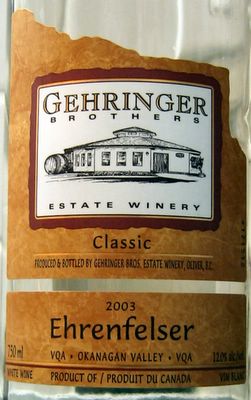
Gehringer Brothers Classic Ehrenfelser 2003
We first encountered the Gehringer Brothers Ehrenfelser on a trip to Penticton, B.C., around 1998. We ate at Granny Bogner's, and had what is still, at least in rememberance, one of our best meals of all time. Granny Bogner's featured, as you might expect, a lot of Canadian wines. We picked this one pretty much at random, and loved it. Ehrenfelser, developed in Germany in the 1920s, is a cross of Riesling and Silvaner. It does well in cool climates, and thus is well-suited to the Okanagan. The wine, on its own, did not perhaps "wow" us in quite the way it did in context during a romantic dinner at Granny Bogner's, but it's still excellent, coming across very much like a dry Riesling, which makes it both a pleasure to drink and very food-friendly. Our rating: 7/10.
Sterling Sterling Vineyard Winery Lake Pinot Noir 1999

Sterling Vineyard Winery Lake Pinot Noir 1999
Pleasant, but not outstanding, this Sterling Vineyard Pinot Noir has a bouquet of berry and wood smoke. It had a brownish tinge, but was still pleasantly tannic and probably would have aged longer. It went very well with a strong-flavored roasted-pepper-and-caper tapenade appetizer. Our rating: 7/10.
30-year-old Noe Pedro Ximenez Muy Viejo Jerez
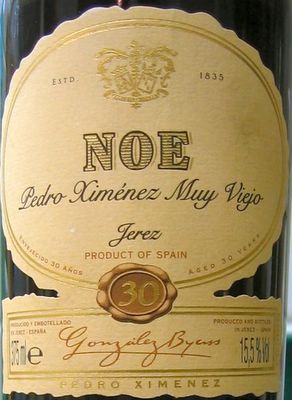
30-year-old Noe Pedro Ximenez Muy Viejo Jerez
While in Calgary we went in search of the Lustau sherry we brought back from last year's trip...and came up dry. Or, rather, with an alternative: this 30-year-old Noe Pedro Ximenez Muy Viejo. At $30 for a half-bottle, it was about the same price as the Lustau. We think we enjoyed the Lustau more...but only slightly. This is still absolutely fabulous wine. Whereas the other made us think "chocolate" on first tasting it, for this one the first note struck was definitely "coffee." Yes, figs and raisins, as you'd expect, but coffee, too, and coffee came through very strongly on the finish. It's so rich that just a little goes a very long way...which, at the price, is a good thing. Our rating: 8/10.
The wines we had at Calgary's River Cafe
We don't have label photos, but here are some brief notes on the wines we enjoyed:
Vielle Ferme Costieres de Nimes Grenache, France: On the dry side for drinking on its own, but went well with food--really blossomed, in fact.
Heartland Viognier-Pinot Gris, Australia: A wonderful floral nose and a nice citrusy taste. Very food-friendly, as both Viognier and Pinot Gris tend to be. It was perfect with teh pea puree that was part of the magnificent seared halibut.
Waterwheel Shiraz , Bendigo, Australia: A lovely, inviting bouquet and bursting with berry flavor, this was a reasonable match with the elk and portabello mushrooms but (not surprisingly) did not go at all with the pear that was also part of that dish.
We highly recommend the River Cafe if you're in Calgary. It's the best restaurant we've eaten at in a long time, anywhere.
Oyster Bay Sauvignon Blanc 2004

Oyster Bay Sauvignon Blanc 2004
To complete our comparison tasting (it didn't start out that way, but that's the way it developed) of New Zealand Sauvignon Blancs, we bought this Oyster Bay Sauvignon Blanc before leaving Calgary (this time on our own initiative instead of at the recommendation of a store employee). This one was better than the Craggy Ridge Vineyard one but not as outstanding as the Cloudy Bay. Nevertheless, it does seem to provide evidence that you can't go too far wrong in New Zealand Sauvignon Blancs if you stick to the ones with "Bay" in their names. It has a grassy nose, and is more on the vegetal rather than fruity side of the flavor ledger, as well, so it's quite different from the Cloudy Bay, but it's an excellent wine of its type. It was a good match for the dinner we served it with, chicken/cumin salad on lettuce, corn on the cob, and potatoes. Our rating: 7/10.
Craggy Range Winery Sauvignon Blanc 2003

Craggy Range Winery Sauvignon Blanc 2003
This one was a disappointment. We mentioned to the Eau Claire Wine Market staffer that we had enjoyed the Cloudy Bay and wondered what else she recommended in a New Zealand Sauvignon Blanc. This Craggy Range Winery Sauvignon Blanc from the Te Muna Road Vineyard (all their wines are single-vineyard wines) is the one she pointed us to, and on the strength of that recommendation, we bought it. And it was...ordinary. And that's being kind. Thin and uninteresting would be less kind. No, it wasn't bad. It was a perfectly satisfactory wine, of the sort hotel bartenders serve to people who simply ask for "a glass of white wine." But after the Cloudy Bay (which certainly cost no more than this one and may even have cost less--we don't have the receipts handy to say for sure), it left us cold. We were most disappointed, however, not in the wine, but in the fact that the Wine Market, which we were otherwise impressed with, let us down so badly. Our rating out of 10: 5.
Cloudy Bay Sauvignon Blanc 2004
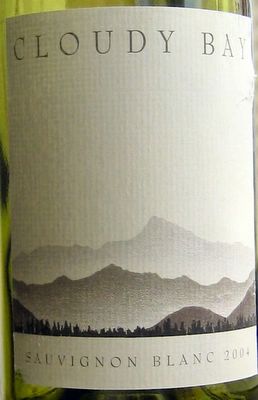
Cloudy Bay Sauvignon Blanc 2004
At the International Wine and Food Festival at the Banff Springs Hotel a few years ago, we had the delightful experience of a Cloudy Bay Sauvignon Blanc tasting. We were both blown away by the rich tropical fruit flavours and bouquet. Ever since, we've followed the dictum that any New Zealand Sauvignon Blanc with "Bay" in the name is bound to be good, while figuring, for some reason, that the actual Cloudy Bay Sauvignon Blanc that had so impressed us would be very expensive. We don't see it in Saskatchewan, but there it was at the Eau Claire Wine Market in Calgary--and it wasn't really all that expensive at all. We bought it and enjoyed it in our hotel (we were there for Westercon 58, a major science fiction convention). It was every bit as wonderful as we remembered, bursting with mouth-watering pineapple and citrus flavours. Yum. Our rating out of 10: 8.5.
Zonnebloem Limited Edition Cabernet Sauvignon 1995
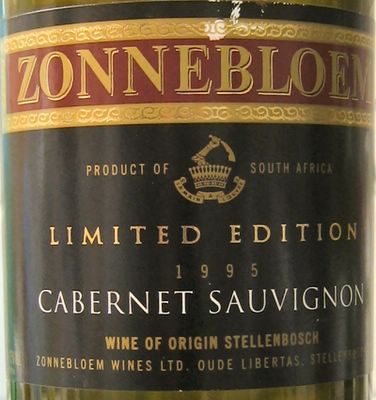
Zonnebloem Limited Edition Cabernet Sauvignon 1995
We think we must have bought this one at the International Wine and Food Festival at the Banff Springs Hotel in 1997, the year South African wines were featured. (It was also more or less our honeymoon.) At the age of 10 years, the wine is very brown, with a smokey, "cigar box" bouquet. It's still full-bodied, with cocnetrated berry flavors and a lovely lingering aftertaste. We found it perfectly balanced, but just possibly on the downhill side of its prime. It went well with spaghetti with a rich, vegetable-and-spices-full tomato sauce. Our rating out of 10: 7.5.
Martinshof Kerner Spätlese 2002

Martinshof Kerner Spätlese 2002
Another of those German wines we ordered through the German Wine Society. Originating in the Pfalz region, this wine was (to quote Ed's first reaction) "yummy." Sweet and fruity, it was very German--in a very good way. We ate it with a variety of foods, and found it went well with Thai noodle salad and also with salty ham. It wasn't so great with salami, which overpowered it, but it wasn't bad with watermelon-feta-olive-lime-juice-cilantro salad. (OK, we're sure there's a catchier name for that salad, but it's too late at night to make the effort to look it up.) Our rating out of 10: 7.5.
Saturday, July 16, 2005
Catching up...
Just in case you were worried about us...
Friday, June 24, 2005
RH Phillips Sauvignon Blanc

RH Phillips Sauvignon Blanc
Our apologies for the lousy label photo; this is the best the pinhole camera in the cellphone could manage, and we didn't have our good camera with us. This R.H. Phillips Sauvignon Blanc (if it had a vintage on it somewhere on the bottle, we missed it) was of the citrusy rather than flinty variety. Very tart, very dry; nice and crisp to drink on its own, but not at all food-friendly--it didn't go with steak (which might be expected), but also didn't go with any of the various salad items, or even the bread. Our rating: 6.5/10.
Interesting note: R.H. Phillips has embraced the screwtop.
Hawthorne Mountain Riesling 2003
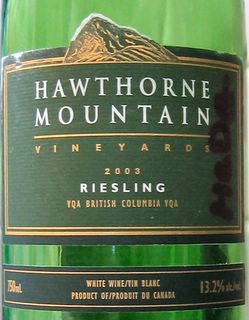
Hawthorne Mountain Riesling 2003
We had this Hawthorne Mountain Riesling from British Columbia at the annual German Wine Society barbecue, so it was natural to think of it in terms of how it contrasted with a typical German Riesling. It was nice and fruity, with lots of flavour--more flavour, in fact, than many a German Riesling, Ed thought at first, but after noting that it's a whopping 13.2 percent alcohol (many German wines are under 10 percent), he decided it was probably the higher alcohol content that gave that impression. It was also quite dry--dryer than many German wines--but well-balanced. Our rating: 7/10.
Clay Station Petite Sirah 2002
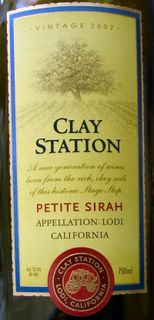
Clay Station Petite Sirah 2002
This Clay Station Petite Sirah took us aback on opening because of a touch of vinegar on the nose, but that cleared off with a bit of swirling of the Riedel glass. (It's a $21 bottle of wine here; we wanted to give it a chance to show itself off.) The initial impression may also have been influenced by the fact that garlic was cooking at the time. Good tannin--it no doubt would have aged longer--but also lots of fruit; Margaret Anne detected blueberry notes. Very nice. Our rating: 7.5/10.
Pokolbin Creek Cabernet Sauvignon 2001
Riverwood Semillon Chardonnay 2002
Stoney Ridge Single Vineyard (Butlers' Grant) Reserve Chardonnay 1995
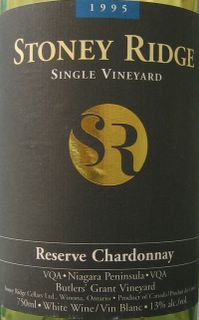
Stoney Ridge Single Vineyard (Butlers' Grant) Reserve Chardonnay 1995
This wine explains perfectly why Stoney Ridge was Margaret Anne's favorite Niagara winery 10 years ago (we haven't had any new Stoney Ridge wines recently, so can't say if that's still true). It has nice tropical fruit, characteristic of Stoney Ridge Chardonnays in the 1990s; just a little oakey, a touch of pineapple, a touch of vanilla, quite dry. Lovely, lovely, lovely. Our rating: 8.5/10.
Domaine St. George Chardonnay 1999

Domaine St. George Chardonnay 1999
We won this bottle of Domaine St. George Chardonnay as a door prize at the Society for American Wines dinner blogged about earlier, and wasted little time trying it. Grapefruit on the nose; very fruity, with lots of grapefruit and melon on the palate, but not cloying. A more refreshing Chardonnay than most! Our rating: 7/10.
Thursday, June 23, 2005
An MRI for wine
Then again, it is a $50,000 device, so it won't be in your kitchen any time soon. And we have our doubts about it completely replacing the human palette when it comes to judging these matters. If a customer sends back a bottle of wine that's been scanned by this thing and pronounced goo, what, is the restaurant going to argue with him? He may be full of hot air, but if he doesn't like the wine, he doesn't like the wine.
Still, for high-end restaurants, auction houses and places like that, it makes a lot of sense, if it works as advertised.
Tuesday, June 07, 2005
A Symphony, a Riesling, a Chardonnay and two Cabs
We attended the Society for American Wines dinner in the lobby of the Saskatchewan Centre of the Arts on Sunday evening, and had a wonderful time. Ed took notes with his new toy, an Audiovox PPC-6600 Harrier cell phone/PDA. It wasn't quite liveblogging--although it could have been!--but it was the next best thing.
The reception wine was a 2003 Ironstone Obsession Symphony. We found it sweet, and fruity (both citrus and melon, but more the latter than the former), with a touch of effervescence. It went very well with the appetizers, especially the spring rolls with plum sauce. It wasn't bad with the chicken satay, but the satay was perhaps just a bit too spicy for it. weet, fruity - melon, citrus (more melon than citrus) - a bit of effervescence - went very well with appetizers especially chicken satay and spring rolls with plum sauce - better with the spring rolls, the satay was a bit too spicy. This wine is $15 or 16 here.
Here's a bit more information about the Symphony varietal, from an article by Sharon Rosenbaum in the November 2004 newsletter of A Taste of California:
"Symphony is a white wine cultivar developed by Dr. Harold Paul Olmo, Professor Emeritus of the Department of Viticulture and Enology at the
The Symphony grape is grown here and there in
The wine served with the luscious butternut squash soup was a 2000 J. Lohr Estates Arroyo Seco Riverstone Chardonnay (the wine's name comes from the hard rock beneath the surface of the dry riverbed near
Two reds, both Cabernet Sauvignons, arrived with the main course of mustard-smeared lamb (which probably had a much grander-sounding name than that, but we lost our menu). The organically grown 1999 Bonterra Cabernet Sauvignon was fuller and fruiter than the 1987 Torres Mas la Plana Gran Coronas, but Margaret Anne nevertheless preferred the Spanish Cab with the lamb. The Torres was perhaps past its prime; it was very brown, some bottles had a lot of sediment, and
Finally, with dessert (a mousse--which, in concert with the soup, had a pumpkin flavor--served in a sweet tulip shell), came the 2000 Hogue Johannisburg Riesling. We were warned that it was "very sweet," but to us veteran German wine-lovers, it didn't seem particularly sweet at all--in German terms, maybe a Spätlese, but certainly not an Auslese. If anything, it was less sweet than the Ironstone Symphony, at least to Ed's mind. Despite its name, it isn't a South African wine, but one from
And that was that. Best thing about the evening: we won a bottle of 1999 Domaine St. George Chardonnay. Watch for our take on that in the near future.
Saturday, June 04, 2005
Lustau East India Solera Sherry, bottled 1997
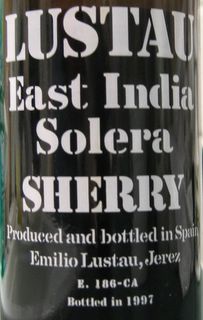
Lustau East India Solera Sherry 1997
From the back label:
"Trading ships sailing to the
"After traveling through the tropics it was discovered that the heat and humidity had matured the wine to a great smoothness. The House of LUSTAU has recreated the same conditions for the ageing of their EAST INDIA SOLERAS and has thus revived this unique style.
"One of the rare Sherries that ages beautifully in bottle, East India Solera becomes rich, unctuous and remarkably smooth with wonderful flavours reminiscent of ripe figs and raisins."
This is a fabulous sherry; we purchased this half-bottle a couple of years ago in Calgary (price: around $20) ostensibly for Margaret Anne's mother, who didn't get a taste of it until Saturday night's dinner. We have promised to only drink more of it when she's around.
We had it with dessert, which was nothing more complicated than iced cherries, and it went beautifully with the fruit. The nose was so rich that it made Ed think more of chocolate than anything else. Much more complex than Bristol Cream, the sherry probably people are most familiar with.
Highly recommended. At least 8/10.
Fetzer Echo Ridge Fumé Blanc 2002

Fetzer Echo Ridge Fumé
This Fetzer Echo Ridge Fumé
This was not a citrusy wine; it was much more on the herbal/flinty end of Fumé
Summerhill Pyramid Winery Kissed Gewurztraminer 2002

Summerhill Pyramid Winery Kissed Gewurztraminer 2002
We had this at the Willow on Wascana restaurant, where we were celebrating Margaret Anne's birthday (for the second or third time--hey, why not?). Although it was highly praised by one of the restaurant's co-owners, we weren't overly impressed. It was very dry, almost sharp, rebuffing your palate instead of welcoming it in. We've had many other Okanagan Valley Gewurtzes we enjoyed more. Our rating: 5/10.
P.S. Ed loves the label, though, since it ties in with that whole fantasy-and-science-fiction-writing thing he does. (Visit www.edwardwillett.com for more details). The artwork is by the great fantasy artist Brian Froud. So the rating for the label is 9/10.
Watering wine in California
His own take on the matter makes eminent sense to us.
Monday, May 30, 2005
Bend in the River Riesling 2003

Bend in the River Riesling 2003
We first tasted this at a German Wine Society event and enjoyed it. Now we've had it at home. Very German. Very typical. Very good. Nothing more to say about it, except we'd buy it again! Oh, and here's a link to the winemaker. Our rating: 7/10.
Wednesday, May 25, 2005
Masi Campo Fiorin 2001
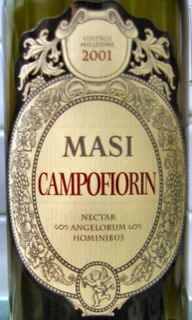
Masi Campo Fiorin 2001
We tasted this Masi Campo Fiorin at a friend's party a while ago, and finally bought our own bottle (for about $20). It's an Italian red which, though its color was on the brownish side, certainly seemed to have the tannins and structure to age for a few more years. A rich, full red with a leathery bouquet (which smelled more appetizing than you might think), and a fruity rather than earthy taste--yet, very dry; nothing jammy here.
We enjoyed it and would certainly buy it again. Our rating: 7/10.
Marqués de Cáceres Rioja 2004
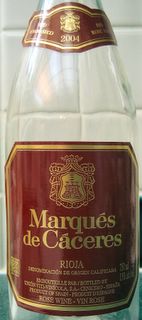
Marqués de Cáceres Rioja 2004
This Marqués de Cáceres Rioja rosé is a perennial favorite of ours. It has a light bouquet--almost non-existent, really--and tastes like a dry white with a red aftertaste. It was very nice with our dinner of halibut with bell pepper-and-olive relish--it's very food-friendly-- but is also refreshing served chilled on its own.
It cost us about $15. Our rating: 7.5/10.
Sawmill Creek Barrel Select Sauvignon Blanc
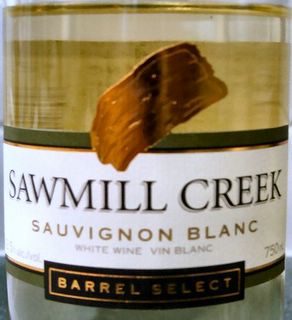
Sawmill Creek Barrel Select Sauvignon Blanc
This is a non-vintage blend which we bought primarily because we needed a cup of white wine for some dish or other and we didn't want to waste any of our better whites. But since it was chilled and open, why not try a glass?
It's OK for cooking, otherwise generic and thin, though inoffensive. It cost us only about $7, and was probably worth that.
Our rating: 3/10.
Rancho Zabaco Dancing Bull Sauvignon Blanc 2003
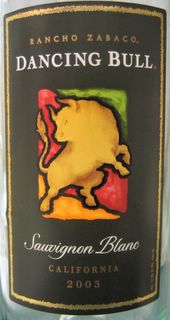
Rancho Zabaco Dancing Bull Sauvignon Blanc 2003
The Rancho Zabaco Dancing Bull Sauvignon Blanc has got a great label--but, alas, the label was possibly the best thing about the wine. "Fairly ordinary" was one comment; Alice (Margaret Anne's mother, not our almost-four-year-old daughter) thought it had a bitter aftertaste. "Not much depth" was a consensus opinion. However, it did have good acidity and it went well with a dessert of fresh rasberries and mangoes.
This one set us back $14.95 in the Saskatchewan Liquor and Gaming Authority store. Our rating (out of 10): 5.5.
Martinshof Ruländer Auslese (Pfalz) 2002
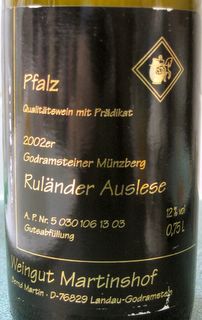
Martinshof Ruländer Auslese (Pfalz) 2002
Pale gold, with good legs; a lovely bouquet--it smells like a German wine, and yet not like a Riesling. And it tastes as lovely as it smells: it's sweet, but not cloying, with just the right touch of acidity and a nice hint of caramel. It has a pleasant, lingering aftertaste. We both love good German wines--and we both loved this one, one of those we ordered through the German Wine Society (which may well mean it's not available in North America, at least not readily).
Our rating (out of 10): 8.
